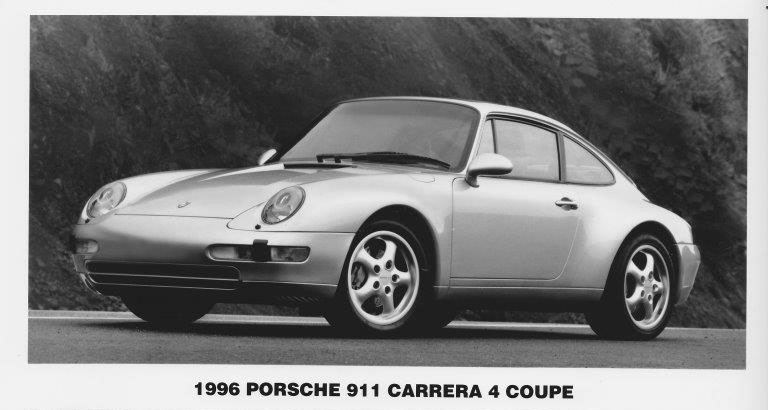.jpg)
1995 Porsche 911 Carrera 4

Extensively redesigned for 1995, the Porsche Carrera 4 is powered by a 3.6 liter, six-cylinder boxer engine. Further modifications for 1996 boosted power output to 282 horsepower (210 kW), Last year's redesign already resulted in a nine percent increase in power without any fuel economy penalty while meeting stringent emission standards. The modest rise in this year's overall numbers masks the real story -a solid boost in the engine's mid-range torque pattern.
The primary means of achieving this improvement was enhancement of Porsche's VarioramTM induction system. The Varioram system optimizes volumetric efficiency for high torque output, resulting in quick throttle response and strong acceleration. Using variable-length intake pipes and separate, differently tuned air-intake systems for medium and high engine speeds, torque and power output characteristics are optimized across the entire usable engine speed range. Intake and exhaust valves are larger; camshafts with modified valve timing and an optimized ignition system have been adopted.
All 1996 Porsche 911 models feature a new system for monitoring all components with exhaust emission control relevance. While the car is being driven, the OBD II (on-board diagnostics, second generation) system measures the efficiency of the catalytic converter, identifies misfiring, and monitors the functions of the fuel system, fuel-tank venting, secondary-air injection, oxygen sensors and other components and systems which affect exhaust emissions. 1996 Porsche 911 models can be visually distinguished by their new "D"-shaped tailpipes.
Power flows out of the engine, through a six-speed manual gearbox optimized for smooth, light and precise shifting, and into the same all-wheel-drive (AWD) system found on the Porsche 911 Turbo. At 111 pounds (50 kg), this system is half the weight of the earlier Carrera 4 AWD system and is 33 percent more efficient in operation. A maintenance-free viscous center clutch controls power distribution between the front and rear wheels. Running in silicone fluid, the viscous clutch responds to power, engine speed and temperature differences to vary the amount of slip between the front and rear axles. If both rear wheels spin, the center clutch diverts engine power to the front wheels, ensuring that maximum traction is always available. A conventional rear locking differential regulates the torque split between the rear wheels. The viscous clutch and rear differential act together to divert engine torque to the wheels with the most traction.
Rear differential action is augmented by Porsche's Automatic Brake Differential (ABD) system. Should one rear wheel begin to spin, the locking differential transmits the power to the other wheel which still has traction. If this is not sufficient, then ABD, using input from the anti-lock brake system sensors, applies braking power to the slipping wheel to help initiate traction. (These functions operate at speeds up to 43 miles per hour [70 kph].) The combination of locking differential and ABD, along with all-wheel drive, provides greater directional stability under all circumstances and offers maximum traction on less-than- ideal road surfaces. All-wheel drive reduces weight transfer differences, which can affect stability, by allowing the maximum of the Carrera 4's weight to be used at all times to help maintain traction.
Every new Porsche sports car is covered by a two-year bumper-to-bumper limited warranty with unlimited mileage, including Porsche's roadside assistance program. The galvanized body and 26-step paint and anti-corrosion process enable Porsche to warrant each car against rust perforation for ten years and unlimited mileage. In addition, the paint has a three year limited warranty.
.jpg)
.jpg)
.jpg)
.jpg)
1995 Porsche 911 Carrera 4
.jpg)
1997 Porsche 911 Carrera 4

Porsche Press kit

Porsche Literature

Our Porsche Cars